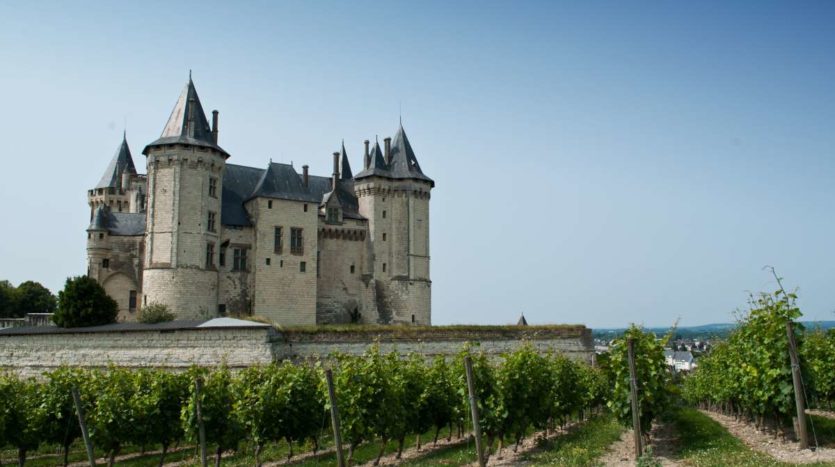The Château De Saumur, Art and War Museum
It’s a castle on the Loire’s banks that, with its perfect whiteness and the attraction of its slate-roofed turrets, lights the city it overlooks. For more than a millennium, successive rulers have reinforced the location, seeing in the view given over Maine-et-Loire an evident strategic position. Saumur, which is both a Unesco World Heritage Site and a historical monument, is a wonder to be appreciated without reservation, with the highlight being the rare artistic treasures housed in the museum that has been established there. The focus will be on the castle of Saumur, its charms, and its turbulent history.
Constant militarization until the end of the 19th century
The fortress’s history began in the 10th century, when Thibaud 1st le Tricheur, Count of Blois, built walls around the Benedictine monastery of Saint-Florent. In 1026, Foulque Nerra conquered it, and his descendants held it until 1203 when King Philippe Augustus of France annexed it and burnt down the old structures.
The building of a keep and buttresses interspersed with four towers, which formed the foundation of the castle that we know today, marked the beginning of the place’s second military existence. Then, over time, a series of adjustments are made. In 1227, King Saint-Louis had the fortification improved, and Louis I of Anjou had the ancient towers rebuilt with new octagonal ones. The location thus becomes a pleasant place to visit, and René d’Anjou attempts to make it more comfortable. It is, however, mostly abandoned for more than a century.
The town and castle were given to the Protestants in 1589, allowing Philippe Duplessis-Mornay, Henri IV’s counsellor, to live there. He oversaw various renovations and the construction of the existing fortifications. Despite the fact that Louis XIV and Mazarin continued to utilize the stronghold, it had fallen into disuse once again. It wasn’t until 1810 that it was turned into a jail under Napoleon’s command. Only four years later, Louis XVIII turned it into a munitions store, causing the Saumur locals to be annoyed by the constant explosions.
All military applications were phased out in 1889. In 1906, the city of Saumur purchased the stronghold from the state and turned it into a municipal museum. It has since undergone various restorations, most notably during WWII and most recently, around the year 2000.

A warlike but elegant castle
Saumur, like Rome, did not emerge from nothing. Originally, the “Wall of Boile” in the 10th century defined an area of roughly 6 hectares with its kilometre in length. Until the 16th century, a number of smaller enclosures appeared.
The first tower built did not last long, since embankments turned the bottom level into a basement. It was simply the beginning of a series of changes that emphasised the location’s fortifications while also increasing its comfort. A Romanesque tower in the 12th century, a Romanesque keep the next century, and finally four great round towers coated in slate and joined by curtain walls all contributed to the beautiful Renaissance architecture that we can see today.
If the proprietors had always intended to turn it into a count’s castle befitting of France, it was the threat of English attack that led the walls to be strengthened and towers to be built. The Champs gate was elevated, the low windows were covered with bars, and the entry to the keep was fortified by a drawbridge, in addition to the several enclosures.
Simultaneously, prestige remained a goal: statues were erected, an honour stairway leading to the great hall was built, and various embellishments such as gazebos must have existed, but no trace of them can be seen now.
Saumur castle today
If your footsteps bring you to Saumur, you will be rewarded with two wonders: the outlook and the museum’s extensive collections. There are displays of decorative arts, fine arts, ethnology, and natural sciences, culminating in one of the country’s greatest collections of ceramics and one-of-a-kind tapestries.
On the second level, the “Horse” collection includes antique horse gear, veterinarian or farrier works, and horse engravings.
The castle’s architectural ensemble is particularly worth seeing, since it provides a fascinating tale about the region’s history. Only the “abbey,” a relic of the mediaeval abbey church, remains of the Abbey of Saint-Florent, which was one of the most significant in western France until the 16th century. The defensive towers and their loopholes give the structure a magnificent appearance, maintaining the idea of calm might of a perched castle that does not descend on its guests.
Children’s entertainment is provided on a regular basis, and families are welcome to picnic in the castle’s park for free, particularly during the summer when an outdoor movie session is held on a weekly basis. Take control of Saumur’s fortress!


